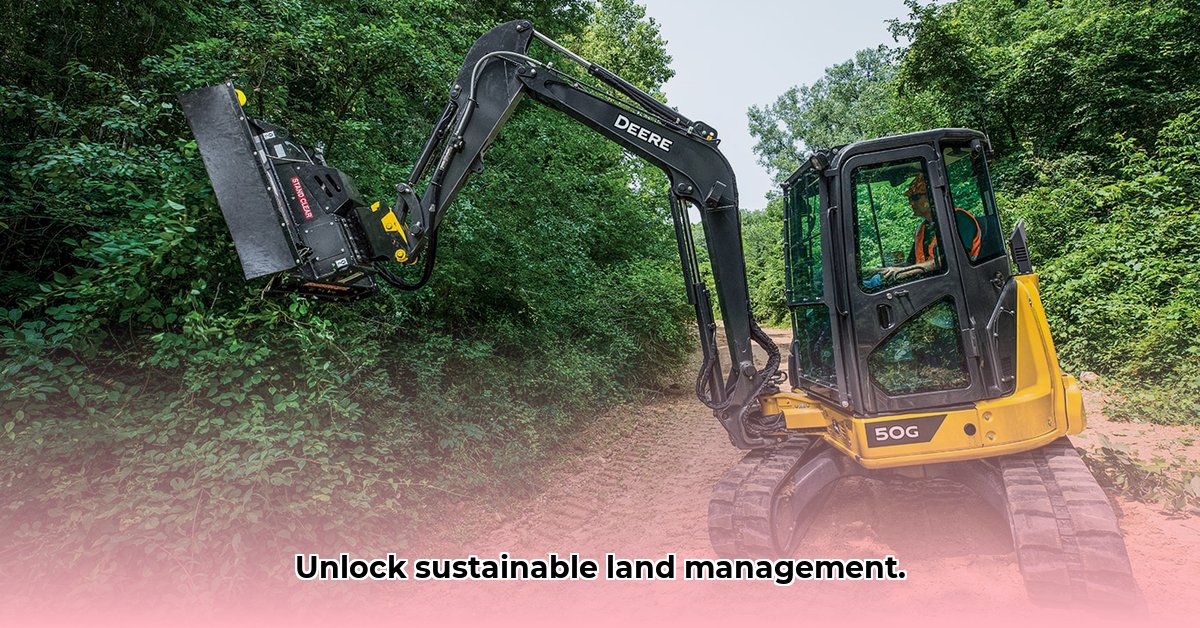
Choosing the right John Deere tractor mulcher attachment can significantly enhance land management efficiency and sustainability. This guide provides a comprehensive overview of John Deere's mulcher offerings, guiding you through selection, operation, maintenance, and environmental considerations. For more information on PTO mulchers, check out this helpful resource: PTO Mulcher Info.
Understanding Your John Deere Tractor Mulcher Attachment Options
John Deere provides various mulcher attachments, each suited for specific applications. Selecting the correct model is crucial for optimal performance and efficiency. Let's examine some popular models:
ME50 Mulching Head: Ideal for large-scale land clearing and dense vegetation, the ME50 boasts high efficiency and durable construction. Its robust design and Cubit knives ensure extended blade life, minimizing downtime. While the initial investment is higher, its long-term durability often justifies the cost for extensive projects. Requires a powerful tractor for operation.
MH60D Mulcher: A versatile option suitable for medium-scale projects and diverse vegetation types. The MH60D strikes a balance between power and cost-effectiveness, making it a reliable choice for various land management tasks. It's ideal when a less powerful but still dependable attachment is needed.
This table summarizes key features and considerations for selecting the appropriate model:
| Model | Ideal Application | Key Features | Considerations |
|---|---|---|---|
| ME50 | Extensive land clearing, dense vegetation | High efficiency, durable, extended blade life | Requires a powerful tractor, higher initial investment |
| MH60D | Medium-scale clearing, varied vegetation types | Versatile, reliable performance, good value | A good balance between power and cost-effectiveness |
| Other Models | See John Deere documentation | Varying sizes, power outputs, specialized features | Match your needs carefully |
Attaching and Operating Your John Deere Mulcher
The Quik-Tatch system simplifies attachment installation. Follow these steps for safe and efficient installation:
Precise Alignment: Carefully align the attachment with your tractor's quick-attach system. Ensuring a perfect fit is critical for safety and performance.
Secure Locking: Engage the locking mechanism firmly. A loose connection poses a significant safety hazard.
Visual Inspection: Before operation, thoroughly inspect all connections to verify secure attachment.
Gradual Start: Begin mulching at a low speed, gradually increasing the speed as conditions allow. This prevents sudden jerking and potential damage.
Continuous Monitoring: Regularly monitor the attachment's performance during operation. This allows for early detection of potential issues and prevents major problems.
Safety Precautions: Always consult the operator's manual. Appropriate safety gear, including eye and hearing protection, is mandatory. Maintain a safe distance from the mulching area and ensure all bystanders are well clear.
Maintaining Peak Mulcher Performance
Regular maintenance is crucial for optimal performance and longevity. Follow this maintenance schedule:
Regular Inspections: Inspect for loose bolts, damaged blades, and other signs of wear after each use.
Blade Sharpening/Replacement: Dull blades reduce efficiency. Sharpen or replace blades as needed to maintain cutting performance.
Lubrication: Regular lubrication of moving parts is essential to prevent premature wear and tear. Follow manufacturer's recommendations.
Storage: Store the attachment properly when not in use to protect it from the elements.
Environmental Impact and Sustainability
Mulching offers several environmental benefits: finer mulch improves soil health, enhances water retention, and may contribute to carbon sequestration. Efficient mulching often reduces the need for other land-clearing methods.
However, a comprehensive assessment requires further research into fuel efficiency and lifecycle environmental impact. John Deere, and the industry as a whole, should conduct comprehensive lifecycle assessments (LCAs) to evaluate the long-term environmental sustainability of these tools. This is crucial to understand the full environmental picture. What steps can we take to reduce overall environmental impact?
Conclusion: Sustainable Land Management with John Deere Mulchers
Mastering John Deere mulcher attachments involves understanding their capabilities, practicing safe operation, and performing regular maintenance. It also means advocating for greater research into the long-term environmental impact of these crucial tools. By combining these elements, we can leverage these attachments for efficient and sustainable land management.